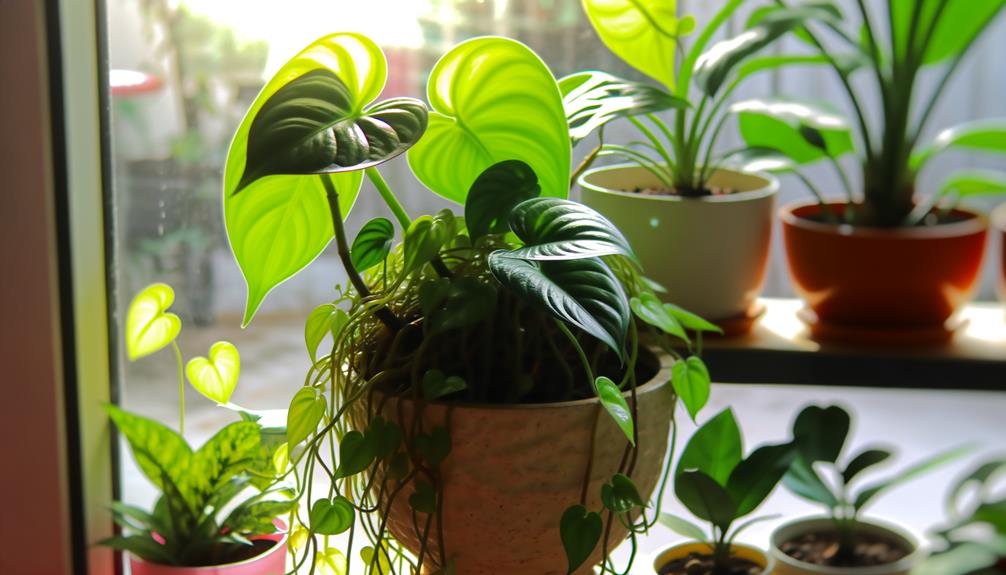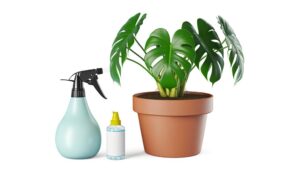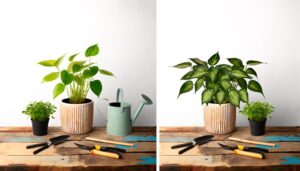Philodendron Wend Imbe Care
Philodendron Wend Imbe thrives in bright, indirect light (10,000-20,000 lux). Water when the top inch of soil is dry to avoid root rot and desiccation stress.
Utilize a well-aerated soil mix of peat, perlite, and pine bark, maintaining a pH of 5.5-7.0. Ideal temperature is 65-80°F with 60-80% humidity.
Fertilize bi-monthly during the growing season with diluted balanced fertilizer. Use sanitized tools for pruning and propagate using healthy stem cuttings.
Regularly check for pests such as spider mites and mealybugs. Proper drainage and soil health are essential for best care.
Discover more detailed methods for ideal plant health ahead.

Key Takeaways
- Place in bright, indirect light with 10,000-20,000 lux for optimal growth.
- Water when the top inch of soil is dry to prevent root rot and desiccation.
- Maintain temperatures between 65-80°F and humidity levels of 60-80%.
- Use a well-draining soil mix of peat, perlite, and pine bark; repot every two years.
- Control pests with insecticidal soap or neem oil and ensure proper drainage.
Light Requirements
The Philodendron Wend Imbe thrives in bright, indirect light, which mimics the dappled sunlight of its natural tropical habitat. This species exhibits prime growth under conditions where light intensity ranges from 10,000 to 20,000 lux.
Prolonged exposure to direct sunlight can lead to photoinhibition, manifesting as chlorophyll degradation and leaf scorching. Conversely, insufficient light impedes photosynthetic efficiency, resulting in leggy growth and pale foliage.
Research indicates that artificial grow lights, emitting wavelengths between 400-700 nm, can effectively supplement natural light. Regular monitoring of light levels, using a lux meter, is recommended to maintain the ideal photic environment.
Providing the accurate light conditions assures the Philodendron Wend Imbe's physiological processes remain robust, thereby promoting vigorous growth and aesthetic appeal.
Watering Schedule
Establishing a top watering schedule for Philodendron Wend Imbe necessitates a nuanced understanding of its hydration needs and soil moisture dynamics. Empirical observations indicate that this plant thrives in consistently moist, yet well-drained soil. Overwatering can precipitate root rot, while underwatering can lead to desiccation stress.
Research suggests watering thoroughly when the top inch of soil feels dry to the touch. Seasonal variations must be considered; increased frequency may be warranted during active growth periods in spring and summer, while reduced watering suffices during dormancy in autumn and winter.
Monitoring environmental humidity can further fine-tune irrigation practices, as elevated humidity levels can mitigate the plant's water requirements. Regular assessment and adaptive management are key to best hydration.
Soil Preferences
Philodendron Wend Imbe thrives in a well-aerated, nutrient-rich soil mixture, ideally composed of peat, perlite, and pine bark to enhance root health. Effective drainage is essential to prevent waterlogging and root rot, making the inclusion of coarse materials such as orchid bark highly advantageous.
Research indicates that maintaining a slightly acidic to neutral soil pH, within the range of 5.5 to 7.0, supports best nutrient uptake and plant health.
Ideal Soil Composition
Perfect soil composition for Wend Imbe typically involves a well-draining mix enriched with organic matter to support its growth and health. Research indicates that a blend of peat moss, perlite, and pine bark creates an excellent environment by retaining moisture while preventing waterlogging.
Peat moss contributes to the soil's acidity and nutrient content, promoting root development. Perlite enhances aeration and drainage, essential for preventing root rot. Pine bark, rich in organic matter, improves soil structure and provides essential micronutrients. An ideal pH range of 5.5 to 6.5 should be maintained to guarantee nutrient availability.
This scientifically grounded approach aligns with the plant's natural habitat, ensuring robust growth and health for those committed to careful plant care.
Drainage Requirements
Proper drainage is crucial for Wend Imbe's soil preferences, as it prevents water accumulation that can lead to root rot and other health issues. Research indicates that a well-draining soil mix, rich in organic matter, is best for this species.
Incorporating perlite or orchid bark can improve aeration and facilitate efficient water movement through the substrate. Observational studies suggest that maintaining a balance between moisture retention and drainage is important; the soil should remain evenly moist without becoming waterlogged.
Implementing a container with drainage holes further reduces the risk of water stagnation. Therefore, ensuring appropriate drainage not only promotes root health but also enhances nutrient uptake and overall plant vitality, enabling the Wend Imbe to thrive.
Soil Ph Levels
An ideal soil pH range of 5.5 to 6.5 is crucial for Wend Imbe's nutrient absorption and overall health. Maintaining this slightly acidic environment facilitates top uptake of macronutrients such as nitrogen, phosphorus, potassium, and micronutrients like iron and manganese.
Research indicates that deviations from this pH range can lead to nutrient lockout, resulting in deficiencies and impaired growth. Regular soil testing is advisable to monitor pH levels accurately. Amendments such as sulfur or peat moss may be incorporated to lower pH if necessary, while lime can be used to raise it.
Temperature and Humidity
Philodendron Wend Imbe thrives in temperature ranges between 65°F to 80°F, with best humidity levels around 60-80%.
It exhibits reduced growth and potential stress symptoms at temperatures below 55°F or above 85°F.
Seasonal climate adjustments, such as increased humidity during winter months, are essential for maintaining its health and vigor.
Ideal Temperature Range
Maintaining a perfect temperature range of 65-80°F (18-27°C) is crucial for Philodendron Wend Imbe, as it thrives in consistent, moderate warmth and high humidity levels of 60-80%. This temperature range closely mimics the plant's natural tropical habitat, promoting best growth and physiological functions.
Prolonged exposure to temperatures below 55°F (13°C) can induce stress, leading to reduced energy and increased susceptibility to pests and diseases. Conversely, temperatures exceeding 85°F (29°C) can cause dehydration and leaf scorching.
To guarantee the Philodendron Wend Imbe remains healthy:
- Monitor indoor temperatures to maintain the perfect range.
- Avoid placing near drafts or heating vents.
- Use room thermometers for precision.
- Employ climate control devices if necessary.
These practices will help in maintaining a favorable environment for the plant.
Humidity Level Preferences
How does one guarantee the best moisture levels for Philodendron Wend Imbe to mimic its native tropical environment effectively? To replicate the ideal humidity conditions, it is essential to maintain a relative humidity of 60-80%. This plant thrives under consistent moisture levels, similar to its native rainforest habitat. Using a humidifier or placing the plant on a pebble tray with water can enhance ambient humidity. Daily misting is also advantageous but should be moderated to avoid over-saturation.
| Humidity Level | Method | Frequency |
|---|---|---|
| 60-80% | Humidifier | Continuous |
| 60-80% | Pebble Tray | Continuous |
| 60-80% | Misting | Daily |
Regular monitoring with a hygrometer ensures the best conditions, preventing potential stress and encouraging vibrant growth.
Seasonal Climate Adjustments
Consistently adapting temperature and humidity levels to match seasonal variations is crucial for cultivating Philodendron Wend Imbe effectively. This tropical species thrives in stable environments that mimic its native habitat. Research indicates ideal conditions include:
- Temperature Range: Maintain temperatures between 65-80°F (18-27°C) during active growth seasons (spring and summer).
- Cooler Periods: Slightly reduce temperatures to 60-65°F (15-18°C) during dormant seasons (fall and winter) to simulate natural cycles.
- Humidity Levels: Sustain relative humidity around 60-70% year-round, utilizing humidifiers or pebble trays if necessary.
- Monitoring and Adjustments: Regularly monitor environmental conditions with hygrometers and thermometers, adjusting as needed to ensure plant health.
These steps promote growth and health, meeting the plant's needs and enhancing its aesthetic appeal.
Fertilizing Tips
To maximize the growth and health of Philodendron Wend Imbe, providing a balanced, slow-release fertilizer every 4 to 6 weeks during the growing season is crucial.
Research indicates that a 10-10-10 NPK (nitrogen, phosphorus, potassium) formulation supports strong foliage, root development, and overall importance.
Observations suggest that consistent nutrient delivery fosters accelerated growth rates and disease resistance.
It is recommended to dilute liquid fertilizers to half strength to prevent nutrient burn, aligning with best horticultural practices.
Additionally, incorporating organic matter, such as compost or worm castings, into the soil can enhance microbial activity, further benefiting nutrient uptake.
Monitoring the plant's response and adjusting the fertilization regimen accordingly ensures vital health and sustained growth.
Pruning and Maintenance
Correct pruning and upkeep of Philodendron Wend Imbe are essential for ensuring ideal plant structure, encouraging new growth, and preventing the buildup of dead or damaged foliage. Regular maintenance optimizes photosynthetic efficiency and mitigates pest infestations.
Implement the following procedures:
- Sanitize Equipment: Always use sterilized pruning shears to avert the transmission of pathogens.
- Selective Pruning: Remove yellowing or damaged leaves at the base to direct energy towards healthy growth.
- Control Growth: Trim back leggy stems to maintain a compact form and promote lateral branching.
- Seasonal Timing: Prune during active growth periods, typically spring and summer, to allow for quick recovery.
Potting and Repotting
Promoting ideal growth and root health, potting and repotting Philodendron Wend Imbe require the use of well-draining soil and appropriately sized containers. Utilize a soil mix incorporating perlite, peat moss, and orchid bark to improve aeration and moisture control.
Containers should have sufficient drainage to prevent root rot, with a diameter 2-3 inches larger than the root ball to accommodate growth. Repotting is suggested every two years or when roots become bound by the pot, usually indicated by protruding roots and slowed growth.
Perform repotting during the active growing season, from spring to early summer, to reduce transplant shock. This practice ensures sustained nutrient availability and supports optimal plant growth, in line with the plant's natural growth cycles.
Propagation Methods
Propagation of Philodendron Wend Imbe can be effectively achieved through the stem cutting technique. This method involves selecting a healthy segment of the plant with at least one node.
This method is often followed by water propagation steps. It promotes root development by immersing the cut segment in water until roots form.
Research indicates that this propagation strategy not only enhances the success rate but also speeds up the growth of new plants.
Stem Cutting Technique
To propagate Philodendron Wend Imbe effectively through stem cutting, it is crucial to select a healthy, disease-free stem that includes at least one node and preferably an aerial root. This method guarantees robust growth and minimal stress on the plant.
Follow these steps to maximize success:
- Prepare Tools: Sterilize pruning shears with isopropyl alcohol to prevent pathogen transmission.
- Select Stem: Choose a mature stem with at least one node and an aerial root to enhance rooting probability.
- Cutting Technique: Make a clean, diagonal cut just below the node to increase the surface area for root development.
- Healing Process: Allow the cutting to air dry for a few hours to form a callus, reducing the risk of rot.
Implementing these steps guarantees a successful propagation process.
Water Propagation Steps
Initiating water propagation for Philodendron Wend Imbe involves submerging the stem cutting in a transparent container filled with clean, room-temperature water to promote root development through hydroponic means. Select a healthy stem with at least two nodes, ensuring precision in the cut to minimize tissue damage.
Place the cutting in the container, ensuring the nodes are submerged while leaves remain above water to prevent rot. Position the container in indirect sunlight, as excessive light can induce algal growth.
Regularly replace the water every 5-7 days to prevent bacterial buildup and provide an oxygen-rich environment. Root development typically initiates within 2-4 weeks. Once roots reach approximately 2 inches, the cutting is viable for transplantation into soil.
Pest and Disease Control
Effective management of pests and diseases in Philodendron Wend Imbe requires a thorough understanding of the common pathogens and insects that can afflict this species. Regular monitoring and prompt intervention are essential. Key pests and diseases include:
- Spider Mites: These tiny arachnids cause stippling and yellowing of leaves. Regularly misting plants can reduce infestations.
- Mealybugs: Identified by their white, cottony masses on the plant, they can be controlled with insecticidal soap.
- Fungal Infections: Often resulting from overwatering, these can be mitigated by ensuring proper drainage and air circulation.
- Aphids: These small, sap-sucking insects can be controlled using neem oil or insecticidal soap.
Implementing these control measures guarantees optimal health and longevity of Philodendron Wend Imbe.
Common Issues and Solutions
Common issues encountered when cultivating Philodendron Wend Imbe often stem from environmental stressors and improper care practices, leading to symptoms such as leaf discoloration, stunted growth, and root rot.
Leaf discoloration, typically manifesting as yellowing, often indicates either overwatering or insufficient light. Maintaining well-draining soil and moderate, indirect sunlight can help alleviate this.
Stunted growth usually results from nutrient deficiencies; using a balanced, water-soluble fertilizer can support healthy development.
Root rot, frequently caused by waterlogged soil, requires immediate attention; repotting with fresh, aerated substrate and pruning affected roots are effective solutions.
Addressing these issues with timely, focused actions ensures optimal growth and essentiality of Philodendron Wend Imbe, ultimately enhancing the caregiver's satisfaction and the plant's aesthetic appeal.
Conclusion
To conclude, the care of Philodendron wend imbe demands meticulous attention to light, water, soil, temperature, humidity, and fertilization.
Proper potting, repotting, and propagation methods, alongside vigilant pest and disease control, are crucial.
Following these guidelines guarantees excellent growth and health.
When it comes to plant care, precision is key.
With systematic approaches and research-supported methods, the Philodendron wend imbe will flourish, showcasing the effectiveness of scientifically informed horticultural practices.






